1959
It was not until August that the first BR/Sulzer Type 2 was officially allocated to the area when D5015 moved from Crewe North (5A) to Camden (1B). Its stay here was brief, by September D5015 had moved to Willesden (1A) and had been joined by D5016. With a view to taking over some of the local Euston workings effective November 2nd, D5018 & D5019 also moved to Willesden, whilst D5008 arrived at Camden on November 4 for empty coaching stock (ECS) duties alongside D8035 - D8038.
It is possible that Willesden might have received more Class 24's at an earlier date had not the Southern Region asked for the loan of a number of locomotives during 1959.
At year end Willesden held D5015/16/18/19 and Camden had D5008.
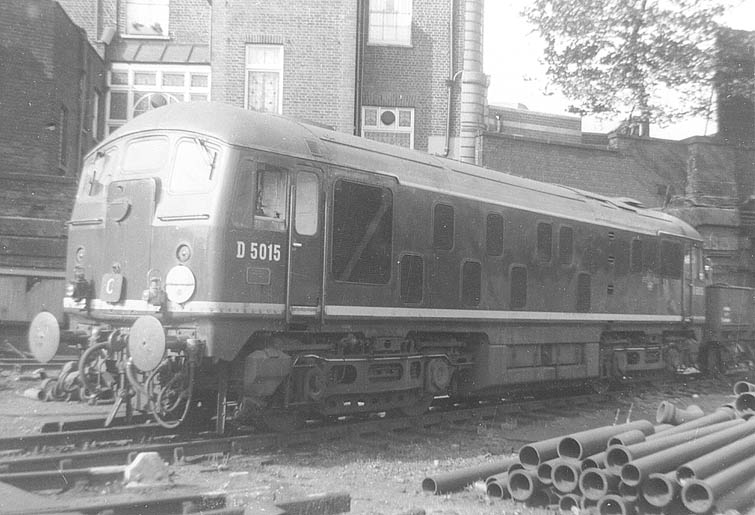

![]()
1960
Early in January D5008 moved to the Southern Region.
Strengthening of the fleet occurred in April when brand new D5072-5075, 5078/79/83 arrived at Willesden. These had originally been built for the Eastern Region, to work out of March (31B), but instead were forwarded quickly to Willesden. On March 31 D5072 & D8035 were noted working a test train down the WCML, whilst D5077 was used for crew training between Rugby & Crewe during the second week of March. The Type 2's also found service on the Broad Street business trains, used alongside the pioneers 10000/01 & 10201/02/03.
During May D5083 moved to Longsight (9A).

Further arrivals during the summer months included D5082 (July) and D5076 & D5077 (August).
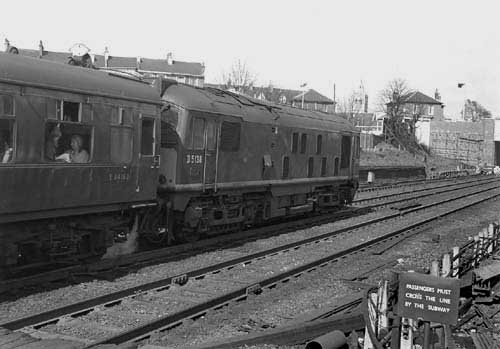
With the timetable changes in October new arrivals included D5059, D5061, D5086, D5087 whilst D5079 moved north to Longsight (9A).
D5016 found itself on front-line duty on October 9th when the down 'Royal Scot' experienced serious difficulties with D222. After a slow departure from Euston and attention at Willesden all was still not well, the Type 4 coming off at Watford, replaced by the Type 2. The small machine put up quite a performance, however the glory was brief, Class 5 44712 took over at Bletchley, with 44938 added at Rugby!
More arrivals for Willesden in November included D5060, D5063 - D5065 from March (31B), whilst D5083 came back from Longsight. Camden gained a solitary D5026 from Stratford (30A). Departures were D5060 & D5083 (again!) to Longsight (9A), D5061 to Rugby (2A) and D5074 to Watford (1C). There were enough Type 2's now on hand to substantially take over the Rugby - Euston stopping services. A traffic survey of passenger trains taken early in November at Watford revealed just over 50% were diesel hauled with the Type 2's prominent on the Euston - Rugby/Northampton locals.
The arrival of a number of Type 2’s at Longsight during November saw them working new turns, one such was the 9.35pm Huddersfield Hillhouse - Willesden Class D freight returning north as far as Northampton on the 2.50pm ex Euston, so noted have been D5083, 5134 - 5137/39.
The next four locomotives to arrive at Willesden in late November/early December were D5143 - D5146, and featured the re-designed cabs with the headcode indicators now mounted on the cab roof. These were the only brand new Class 24's that Willesden received direct from the builders. More arrivals in December were D5027 & D5032 from Stratford (30A) and D5133 from Crewe North (5A). One departure was D5087 to Cricklewood (14A).
At year end Willesden held D5015/16/18/19/27/32/59/63-65/72/73/75-78/82/86, D5133/143-146. Camden had only D5026.
![]() 1961
1961
The New Year brought D5030 & D5031 to Willesden from Stratford (30A) whilst D5086 moved to Cricklewood (14A). The out & back turns familiar to the Type 2's included some oddities. On Saturday's after working a Euston - Rugby local, the Type 2 then worked the 5.25pm Rugby - Peterborough local, returning on the
8.32pm Peterborough - Northampton. Another wandering Rugby turn, often using Willesden Type 2's involved the 4.44pm Northampton - Birmingham New Street, returning south with the 7.37pm service to Euston. The ratio of diesels on passenger turns through Watford was now up to 60%.
During February D5059 moved to Watford (1C) whilst D5060 returned from Crewe North (5A).
An exchange of Type 2's took place in March with D5024/28/29/33/34 received from Ipswich (32B) & Stratford (30A), Willesden sending D5059/60/63/64 to Finsbury Park (34G). Other arrivals were D5061 from Rugby (2A) and D5083 from Longsight (9A). Camden received D5022 from Ipswich (32B).
Four Willesden Type 2's now stabled overnight at Northampton to take up the morning 7.02, 8.00 & 8.40 services to Euston and the 7.13 to Peterborough. Three stabled at Bletchley to work the morning 5.42 & 7.30 to Euston and the 6.20 Bletchley - Northampton followed by a semi-fast to Euston. Diesel hauled passengers trains through Watford in April now totalled 80%.
New arrivals to Willesden in the spring & summer included D5035 from Stratford (30A)(April); D5020 & D5021 from Stratford (30A)(May) with D5065 & D5072 traded to Finsbury Park (34G); D5079 came back from Carlisle (12A)(June); D5025 from Ipswich (32B)(July) with D5061 traded in exchange to Finsbury Park (34G).The transfer of D5020/21 to Willesden (1A) during May completed the movement of sixteen Type 2’s (D5020 - 5035) between the GE and the LMR. This was made possible by the newly arriving EE Type 3’s and Brush Type 2’s upwards from D5694, and permitted more of the local services out of Euston to be dieselized.
When not required on the summer weekends the Type 2's were frequently employed on extras to the coast, such was the case for D5082 on Whit Sunday (May 21st?) powering a Bletchley - Bognor Regis excursion throughout.
D5146 had been loaned to Foar Oaks (21E) for crew training during May, it was returned to Willesden during July.
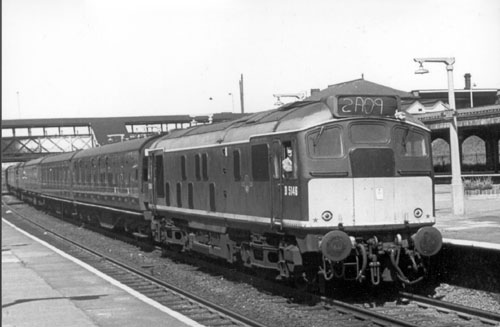
With effect from September 11 Camden lost its allocation of steam locomotives. September 29 proved to be a bad day for incidents on the southern end of the WCML. Included in the tale of woes was the catching fire of D5142 at Carpenders Park about midday whilst working a Camden - Edgeley freight. Much traffic had to be diverted via the slow lines whilst the obstruction was dealt with.
At year end Willesden held D5015/16/18-21/24/25/27-35/73/75/76-79/82/83, D5133/143-146. Camden had D5022/26.
![]() 1962
1962
Type 2's transferred to Camden were D5134 (January), D5135 (March) and D5142 (February), all transferred from Longsight (9A). The latter locomotive was clearly undecided as to its home depot for in March it headed north to Derby (17A), returning to Camden in April only to head back to Longsight (9A) by month end!
During March the Southern Region commenced returning to the LMR it's loaned Type 2, the first to reach Willesden was D5003, whilst D5011 & D5017 followed in May. These three did not stay long, by June they had moved north to Rugby (2A). Also sent north, this time to Carlisle (12B) was D5133.
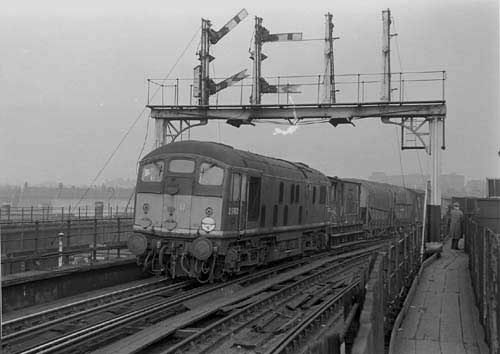
When not working the passenger services out of Euston, many of the Class 24's were used on many & varied freight duties, they were also heavily used on the engineering trains required for the WCML electrification. Seen here at Willesden High Level is D5063 with a southbound freight on January 30th 1964.
More ex-SR arrivals were pioneer D5000 (June), D5001 (July to Willesden) and D5008 (July to Camden) whilst D5023 arrived at Willesden from Watford (1C). With the return of the loaned ex-SR Type 2's there were now enough diesels to oust steam from the Birmingham - Rugby locals, additionally Willesden's allocation frequently showed up on the Birmingham - Coventry locals. Elsewhere they handled certain parcels workings out of Marylebone.
Minor changes in October found Camden surrendering D5134 & D5135 to Longsight (9A), who in exchange sent D5140 & D5141 to Willesden! Two more arrivals from the Southern Region were D5004 (October) and D5007 (November), both transferred to Willesden. D5007 was the last of the loaned Type 2's to return, and like most had been through the repair shops at Eastleigh prior to heading north.They were still common visitors south of the Thames, one consistent trip worked was a morning parcels from Willesden to East Croydon.
After several months at Camden D5008 moved to Carlisle (12B) during November, only to return south to Camden in December.
At year end Willesden held D5000/04/07/15/16/18-21/23-25/27-35/73/75/76-79/82/83, D5140/141/143-146. Camden had D5008/22/26.
![]() 1963
1963
The New Year opened to one of the 'great' winters of our time. It's effect on the diesels is well documented, and the allocation at Willesden and Camden suffered as much as any others. At one point there were only three Type 2's available for the services out of Euston, with a whole variety of steam locomotives filling in betwen January & March. The principal cause of failure was the locomotive's train heating system,
these had already proved un-reliable due to the levels of vibration encountered, with extremely low/freezing temperatures added for a considerable length of time their reliability plummeted further still. The disruption to freight traffic in the London area saw many unusual visitors to the SR on a variety of cross London freights, with a number of Willesden’s Type 2’s reaching Redhill and Three Bridges.
Reallocations in this period were minimal, in January D5008/82/83 moved north to Crewe North (5A), whilst in February D5001 & D5031 arrived at Willesden from Watford (1C).
The Type 2's were now being used widely on the increasing electrification activities. To the north this work had reached Coventry and Nuneaton, whilst at Euston the Euston Hotel closed on May 13 to allow for demolition.
During June D5140 & D5146 visited Margate with a day excursion from Northampton?? Out of Marylebone one of the round trips to Nottingham converted from Type 2 haulage to a four car DMU. The electrification continued its march south, with the Stafford - Tamworth section energised from July 8 and crew training now available at Nuneaton. By September lines in the vicinity of Rugby electric depot had been energised with E3054 brought in for training purposes. Further south Camden shed closed to all steam on September 9th.
In September D5000 & D5001 moved to Crewe North (5A), but returned to Willesden in October.
By the year's end the wiring was complete as far as Rugby. Two late transfers in November were D5009 & D5012 to Willesden from Crewe North (5A). Finally as evidence of the increasing diesel fleet, pioneers 10000, 10201/02/03 were withdrawn from Willesden during December.
At year end Willesden held D5000/01/04/07/09/12/15/16/18-21/23-25/27-35/73/75/76-79, D5140/141/143-146. Camden had D5022/26.
![]() 1964
1964
With more electrics and Class 47's available elsewhere the Euston - Rugby locals saw a greater use of cascaded English Electric Type 4's, the displaced Class 24's swiftly commandeered for the many engineering trains required by the electrification work. By March regular electric haulage from the north was reaching as far as Nuneaton, whilst Rugby now had three electric locomotives on hand for
crew training in addition to AM4 unit E046.
During May D5146 moved to Longsight (9A). Advancing construction projects found the new electric depot at Willesden taking shape, whilst down the road at Camden all diesels were now stabled in the open, by July the shed buildings had been demolished although the coaling plant was still intact.
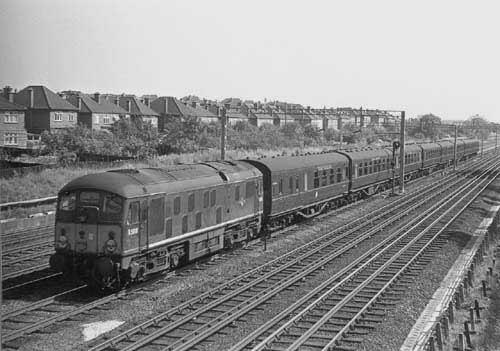
Its August 3rd 1964 and a down Northampton service is seen passing South Kenton behind D5018. Being one of the first twenty built this locomotive carries five ventilators on the upper row and is one of those equipped with the Athermos axleboxes.
At the end of August D5091 moved to Willesden. Wiring was now complete north of Denbigh Hall (Bletchley).
The electrification scheme had concentrated on the Crewe - Nuneaton - Rugby 'Trent Valley' route, (the route south to Kilsby was now energised) now during October the Rugby - Coventry line saw the wiring trains arrive in force. By mid November electric working commenced between Nuneaton & Rugby, two weeks later over 75% of the trains were electric hauled. Transfers to Crewe North (5A) in the last months were D5144 & D5145 (November) & D5009 & D5012 (December), whilst D5087/89/90/92/93 moved to Willesden during December.
At year end Willesden held D5000/01/04/07/15/16/18-21/23-25/27-35/73/75/76-79/87/89-93, D5140/141/143. Camden had D5022/26.
![]() 1965
1965
With the advancing electrification and the general steam ban south of Crewe the remaining steam allocation at Willesden could generally be found working occasional Northampton 'locals', Euston ECS duties and certain Great Central workings. Class 40's still continued to dominate the passenger workings south of Rugby, with Rugby itself getting an allocation, leading to the station pilots becoming diesel duties. From January 4th freight and passenger workings north of Rugby were almost completely in the hand of the electrics.
Transfers in January were D5000/01/04/07/09/20/21/23 from Willesden to Camden, with D5012 going to Rugby (1F) and D5035/74/81 transferred in to Willesden. Also moved into the London area were seventeen Class 40's. Despite these re-allocations Willesden continued to experience locomotive shortages.
In February D5000/01/04/88 moved to Willesden followed by D5084 in March. Watford shed (1C), which from time to time had a small allocation of Class 24's closed on March 29th.
By April the Rugby - Coventry electrification was almost complete whilst Euston saw the beginnings of the installation of the masts and overhead catenary. Steam was still well in evidence during April, the local allocations being Willesden:67, Bletchley:34 & Rugby:14. Crew training with EMU's commenced between Watford & Tring, whilst diesels now started to stable at Willesden's new electric depot. Arrivals to Willesden in April were D5085/86.
Rugby shed (1F) closed to steam on May 24th, whilst watering facilities were withdrawn at Euston.
At the beginning of July D5143 moved north to Crewe North (5A). Bletchley steam shed (1E) closed on July 5th, the new electric depot opening at the same time. A week later the new power signal box at Willesden opened, causing much disruption to traffic over the weekend. On July 19th the entire line from Northampton to Queens Park went live, with electically hauled freights now permitted as far south as Northampton. During the summer a Willesden Type 2 working involved the 01.40 Marylebone - Leicester newspapers, the locomotive returning light engine.
September 27th proved to be a turning point in the electrification scheme with through electric freight workings established between Rugby and Willesden, via Northampton. On the same date Northampton & Willesden sheds closed to steam.
Re-allocations in October were D5083 & D5143 to Willesden. By early November testing of the electric services had commenced at Euston, with a regular service beginning on a snowy November 22nd. Additionally the Euston - Rugby/Northampton locals were now in the hands of the AM10 EMU's. Coventry drivers were now being trained on the new electric traction.
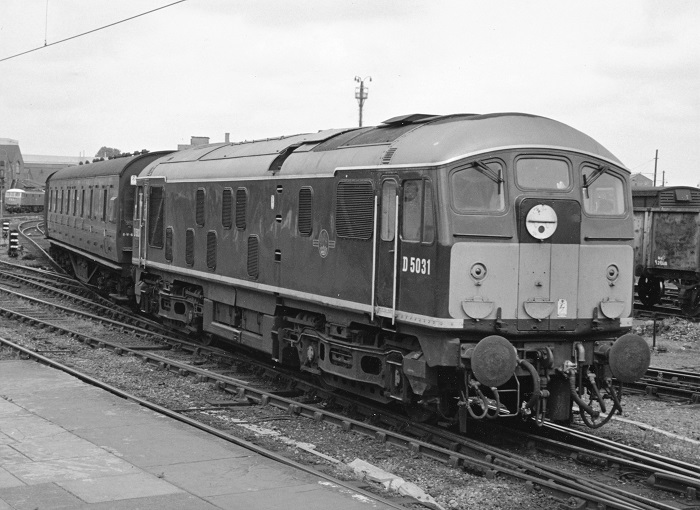
With the southern end of the WCML now well and truly in the hands of electric traction there began a gradual move north of the diesels. Thirty four Class 40's headed north to Bescot (2F) and Crewe (5A) along with nineteen Class 24's. These moves left Camden without an allocation, the shed closed completely on January 3rd 1966 although diesels still layed over in the yards. Effective December 13 more EMU's replaced the diesels on the Euston - Bletchley - Northampton - Rugby locals.
Reallocations were:
D5007/09/16/18/19/25/32, 5140 to Bletchley (1E),
D5015/20-24/26/29, 5141 to Bescot (2F),
D5083 & 5143 to Crewe (5A).
The reallocations of twenty eight Class 40's and ten Class 24's to Bescot allowed that depot to retire forty steam locomotives.
![]() 1966
1966
More Class 24's moved away in January, D5008/17/27 to Rugby (1F) and D5028/30/33/34 to Bletchley (1E). On January 4th the last remaining steam locomotives at Willesden were towed away to Cashmores, Great Bridge, leaving the Western Lines (London Division) with only four steam locomotives on their books, Wolverton Works still retaining its four 'Jinties'. Also dumped at Willesden was 10001. Bletchley's Type 2's were available for freight workings
on the Oxford/Cambridge route as well as other local workings. North of Rugby all freights over the Coventry route were now diagrammed for electric haulage.
During April D5014 moved to the London Division (D01), the LMR now using divisonal allocations for its main line fleet. D5013 moved north to Crewe (D05) in May whilst a temporary arrival at Willesden for crew training was D7650. This locomotive was virtually brand new at the time, having only just been received by the Nottingham Division (D16) from Beyer Peacock. This was in anticipation of a batch of the new class 25's arriving from Derby Works by the end of the year. These locomotives were to be dual braked to handle the car sleeper duties between Willesden and Kensington.
On June 6th services ceased on the Rugby - Peterborough line, with Willesden's D5085 in action on this last day. It hauled the last Birmingham - Yarmouth with ten coaches to Peterborough, here D5526 took over. D5085 was then available to handle the final westbound, the 20.12 Peterborough - Rugby, the locomotive on the final eastbound, the 20.52 Rugby - Peterborough remains to be identified.
During the summer (July) ten Type 2's, D5010/11/14/16/17/19/25/27/28/30 moved north to the Birmingham Division (D02) whilst only one Type 2, D5143 came south to the London Division (D01) in August.
On September 3rd, the last day of through workings on the Marylebone - Nottingham Victoria line, there were at least two Class 24's involved in those workings. The 8.15am Nottingham Victoria - Marylebone headed by 44872 got no further than Aylesbury where the Black Five was replaced by D5089. This worked into Marylebone, the return working, the 14.38 to Nottingham Victoria was hauled by D5000! The final working of the day, the 22.50 (SO) Manchester - Marylebone, comprised of three coaches and one parcels vehicle was hauled by D5089 from Woodford No 2 to Marylebone arriving in the early hours of the 4th.
During September more moves north took place with D5013/18 going to the Birmingham Division (D02) whilst D5001/83 came to the London Division (D01). In October D5031/32/33 headed to the Birmingham Divsion. Although steam had been absent from Willesden for a while much of the infrastructure still remained. In trying to dynamite the coaling tower the contractors only partially succeeded in bringing it down. It was left to the crews with the wrecking ball & crane to finally flatten the structure.
Finally in November the first of twelve dual braked class 25's arrived from Derby Works, D7660 - D7671 would be delivered between November 1966 and March 1967. These were the first Class 25's to be delivered from new in the BR corporate blue livery. With their arrival more Class 24's headed north during December, D5073 - D5081 moved to the Stoke Division (D05), whilst Longsight (9A) recieved D5091 in exchange for D5134. Also heading back north to the Nottingham Division (D16) was D7650, its training days at Willesden now finished. Having finally disposed of the coaling plant the contractors then demolished the steam sheds at Willesden, the site being completely cleared to allow work to commence on a new freightliner terminal. Diesels were now stabling at Stonebridge Park.
Willesden's Class 25 fleet at year end comprised D7660 - D7666.
![]() 1967
1967
Further encroachment of the electrification plans found the Rugby - Coventry - Wolverhampton local services operating from January 1st with AM4 EMU's.
D5082 & D5083 moved to the Stoke Division (D05) in January.
New arrivals in February were D7502 & D7513 to the London Division (D01). On February 16th front line duty befell D5060 when it was required to assist the 06.45 Holyhead - Euston forward from Tring when E3005 developed problems.
The last of Willesden's new Class 25's, D7669 (received out of order) arrived during March, whilst more Class 24's headed north, D5034/35 to the Birmingham Division (D02), D5085 - D5093 to the Stoke Division (D05) with D5134 going to Longsight (9A). Two of the newest arrivals, D7670 & D7671 moved to the Nottingham Division (D16), replaced by D7656 - D7659.
A Willesden Type 2 was used to assist contractors in the lifting of the Banbury - Verney Jct line, in the third week of March D7502 was used on this duty. Another duty for one of the diminishing Willesden based Class 24's was a parcels working in the Coventry area. The duty began at Leamington with a light engine move to Coventry to work the 03.30am parcels to Leamington. The locomotive then ran light back to Coventry to work the 06.15am parcels to Nuneaton, returning light engine to Leamington. The locomotive would then remain idle from 11am to 7.30pm, though occasionally would run light engine to Hawksbury Lane to take the 16.30pm Mobil Oil train to Coventry, with an electric going forward to Coryton. A return would then be made to Leamington to take up the 7.32pm parcels to Nuneaton, returning at 9.38pm to Leamington. The locomotive would then remain idle until the following early morning, before a light engine move to Coventry to repeat the cycle. For much of March D5059 was in charge of this turn.
April saw the transfer away from Willesden of the final Class 24's still allocated there, D5000 - 5009, 5057 - 5060 & 5084, all being moved to the Stoke Division (D05). Sent to partly replace them were D7560 - 7564 from Toton and D7644 - 7646 from Tinsley.
During July the former site of the Willesden carriage sheds was prepared for the building of a Proler auto re-processing plant, scheduled to open during the autumn. The following month D7502 & 7513 moved to the Soke Division (D05), whilst in in November D7560 moved to Springs Branch (8F).
As the year closed out the London Division (D01) Type 2 fleet consisted of 7561 - 7564, 7644/45/46, 7656 - 7669.
![]() 1968
1968
The southern end of the WCML was now pretty much done with the modernisation/electrification plans and the local locomotive fleet stabilised with its plethora of electrics for the majority of the mainline duties and Classes 08/20/25 for the shunting, station pilot and local trip workings. Transfers in and out of the area for the Class 25's would continue for many years to come. Only the highlights are detailed below.
During April 7669 received minor damage in a mishap in the Willesden area.
Effective June 17th the LMR revised its Divisional allocation codes discontinuing the D14, ML & WL codes, placing all the London area Type 2's under the new D01 (London Division) code. This brought to Willesden a block of boiler equipped Type 2's, previously 'allocated' to Cricklewood, these being D5213 - D5225, which were frequently assigned to Royal Train workings emanating from Wolverton.
Following this re-alignment the London Division (D01) was now home to D5194, 5213-5225/41/70/71, 7563/64, 7644-7646, 7656-7669, a total of thirty six Type 2's. These locomotives could be found working out of Cricklewood or Willesden.
By the end of summer 7561 - 7564 had moved on, the first two to the Birmingham Division (D02), the other two to Preston Division (D10).
Two boiler equipped locomotives, 5226 & 5227 arrived in October, their stay was brief, during December they moved on to the Nottingham Division (D16), along with nine other Class 25's from Willesden. The London Division (D01) Class 25 fleet at year end was 5213 - 5224, 5241, 5270 - 5272, 7644 - 7646, 7660 - 7669.
![]() 1969
1969
The Duke of Edinburgh's visit to the Yorkshire area on June 26th utilised a four coach train hauled by 'Royal Regulars' 5226 & 5223 (D01).
A trip to deepest Sussex was made by 5214 on July 13th being sent from Cricklewood to Lewes to recover 41 which had failed on the previous day's 19.19 northbound service. The Peak had only reached Southease before expiring, E6031 pushed the train into Lewes, sidelining the Peak, then taking the train to Clapham Jcn where 18 had arrived to take over. That same day (12th) an Open Day held at Cricklewood Diesel Depot featured three preserved steam locomotives: 45428, 5593 & 7029, two LMR electrics E3044 & E3156, Peak 36, HS4000 and two diesels frequently found on Royal Train Workings, 216 & 5223.
Re-allocation activity during the first half of 1969 was negligible. Thirteen Class 25's arrived in July & August, including early members 5183 - 5186 and others 7529 - 7537 & 7643. Some of these transfers covered the loss of English Electric Type 1's 8000 - 8005, which had moved to the Nottingham Division. The Type 1's had been at Willesden since delivery, now the only diesels allocated here were the Class 08 & 25's. All the local freight duties, including the Euston station pilot and parcels workings were in the hands of Class 25's. ECS movements included the Perth car sleeper from Stonebridge Park to Olympia, returning with the 15.15 & 15.22 services from Olympia as far as Willesden.
During November 5186 arrived leaving the year end allocation at Willesden as 5183 - 5186, 5213 - 5223, 7529 - 7539, 7644/45, 7660/61/66 - 69.
![]() 1970
1970
With the operating requirements at Willesden pretty much stabilised the transfers of locomotives seemed to operate on the 'one in/one out' principal as detailed following:
February in 5270/71, out 7643 to the Liverpool Division (D08)
May in 7662, out 7535 to the Birmingham Division (D02)
June in 7535, out 7645 to the Birmingham Division (D02)
The Royal Train again received Class 25 haulage on May 9th when 5206 & 5223 (D01) worked the Queen Mother from Selly Oak to Bedale (for Catterick) where the train stabled overnight before returning to Wolverton as ecs the next day.
On August 8th memories were stirred when a pair of Class 24's, 5032 & 5040 reached Willesden on a London bound coal train. They quickly returned north light engines, Class 24's were by now rarely seen south of Rugby. For the Class 25's at Willesden a number of brake tenders were supplied to assist them with the Chelsea Basin - Willesden coal workings.
On the south side of London Hither Green was frequently visited by Willesden’s Class 25’s, the 8M83 14.52 Hither Green - Willesden being regularly used to return the visitors to the LMR, so noted in a short period during October were 7531, 7662/67/69.
Willesden's fleet at year end was 5183 - 5186, 5213 - 5223, 5271, 7529 - 7539, 7660 - 7662, 7666 - 7669.
![]() 1971
1971
Re-allocations for 1971 were at a higher level than the previous year, though generally the fleet size at Willesden remained constant.
January in 7606/07/10/21/29/58, out 7538/39, 7666 - 7669 to the Birmingham Division (D02).
February in 7655
March in 7650, out 5271 to the Liverpool Division (D08).
May in 7626, 7663/64, out 7610 to the Birmingham Division (D02) & 7635/36 to the Liverpool Division (D08).
July in 7665/66, out 7621, 7655 to the Birmingham Division (D02).
At the close of the summer timetable a major reorganisation of the locomotive fleet took place, specifically targeting withdrawal of of the remaining NBL & Clayton types on the Scottish Region and certain of the hydraulics on the Western Region. Despite the withdrawal of three percent of the fleet and transfers of ten percent, Willesden was little impacted by all this activity.
October in 7525 - 7528, out 7606/07/26 to the Nottingham Division (D16).
December in 7554/55, out 7534/35 to the Birmingham Division (D02).
Allocation at year end was 5183 - 5186, 5213 - 5223, 7525 - 7533/54/55, 7629/50/58/60-66.
![]() 1972
1972
January in 7536
February out 7536 to the Manchester Division (D09).
Activity at the southern end of the WCML during February featured alot of 'foreign' diesel locomotives, the impact of the coal miners strike brought about disruption to the electricity supply, with BR switching to diesel haulage where possible to conserve electricity.
March in 7639, 7674, out 7554 to the Liverpool Division (D08).
April in 7593/96, 7626, out 7532/33 to the Birmingham Division (D02).
With the introduction of the summer timetabled Stirling - Dover motorail (from May 26 to Sept 23) a pair of Willesden's Class 25's were required to bank the train up to North Pole Jct, presumably Control felt the diagrammed southbound Class 33 required assistance at this point.
During the summer further inroads into the Western Region hydraulic fleet took place. This time the reshuffle of locomotives did impact Willesden's fleet with a number of 'long stayers' moving to pastures new, not simply a shuffle within the LMR, but venturing to ER & WR depots.
July in 7586 (ex-ER), out 5213 to Bristol (82A) and 5223 to the Nottingham Division (D16).
August provided more re-allocation activity than normal with 5212, 5293, 7522/23/24/32/33/65/66/67 transferred in, outgoing were 5183/84, 5214 to Leeds Holbeck (55A) and 7626/39 to the Nottingham Division (D16).
September in 5187 & 7570, out 5293 to the Manchester Division (D09) and 7522 to the Preston Division (D09)
October 5185 to Tinsley (41A), 7523 to Manchester Division, 7629 to Birmingham Division (D02), 7650 to Liverpool Division (D08).
November 16th saw 5221 (D01) & 5222 convey a five coach Royal Train with Princess Anne aboard from Euston to Hope. The train returned ecs to Wolverton via the Midland to Market Harborough.
December in 7522, 7633 & 7650.
A new stabling point for Willesden's Class 25's opened next to the signing on point at Stonebridge Park, combining those that had been at the carriage shed and near Brent Yard.
Willesden's Class 25 fleet at year end comprised 5218/19/21, 7522/24 - 33/55/66/67/71/72/86/96, 7600/45/50/60/61/74.
![]() 1973
1973
December 1972's recent arrivals 7633 & 7650 headed north to Liverpool Division (D08).
Royal Train duty befell 5218 & 5219 on February 14-16th. The Duke of Edinburgh journeyed from Euston, at 23.00 to Sheffield via Northampton & Leicester. Twenty four hours later he returned to Lamport, near Market Harborough, with the five coach train stabling overnight, before leaving at 7am for Leatherhead via the west London line, Clapham Jcn, Selhurst, West Croydon & Sutton. On return the Class 25's ran through to Dorking, there running round heading back to Wolverton via Sutton, Mitcham Jct & Clapham Jct. Overnight heating was provided by a heater van delivered by 5221.
During March 7571/72, 7600/45 arrived at Willesden whilst 7570 & 7658 headed to the Nottingham Division (D16).
May in 7523 & 7564
June in 7622, out 7522 to Crewe.
Ascot Week saw a number of specials arriving in the hands of Class 47’s, however two from Manchester Piccadilly received Class 25’s between Willesden and Ascot, 7523 & 7530 on June 20th and 7645 & 7662 on June 21st.
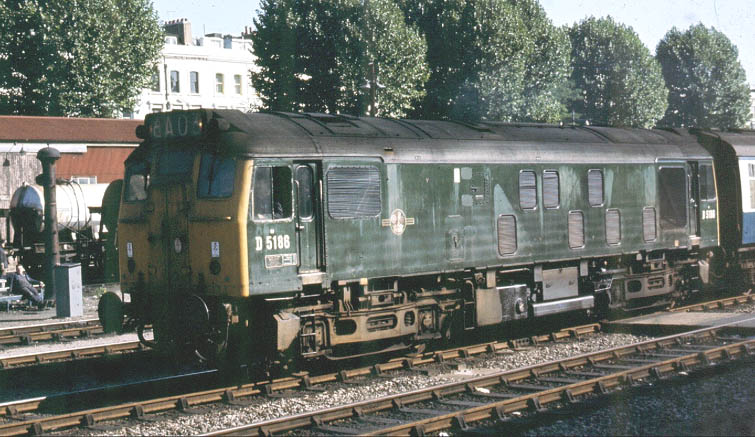
July in 7534 & 7535.
August in 7592, 7658 & 7659.
September in 7606 & 7607, out 7571/72 & 7586 to Crewe.
October out 7606 & 7607 to Toton.
November out 7567 to Longsight.
![]() 1974
1974
January in 7522 & 7665, out 7566 to Eastfield, 7645 to Cricklewood.
February in 7536 & 7537, the latter quickly moved on to Bescot.
March in 25221 & 25222, out 7622 & 25315 to Cricklewood.
April out 7522 to Cardiff
May in 25036, 25236/243, 25312/315, out 25205 to Cricklewood
June in 25265, out 25243 to Cricklewood.
On May 5th the electric current between Bletchley & Watford was 'off' for engineering works, eleven Class 47s and Willesden's 25242 & 25311 were used to haul the electric trains through this section of track. The next day 25068 & 25069 were used to take the Queen, on the Royal Train from Scunthorpe to Lowton.
August in 25072, out 25036 to Cricklewood.
October out 25186
On November 6th the empty Royal Train was taken to Kings Lynn by 25069, the locomotive returned south whilst the Royal Train later headed out to Balmoral.
At this time the Class 25's diagrammed for the Fletliner service changed to Longsight allocated locomotives, with them filling in on local turns (principally to Bletchley) whilst in the London area.
![]() 1975
1975
January in 25070
March in 25185 & 25190
Towards the end of March a dispute arose involving maintenance and workshop supervisory staff. In the Willesden area this had an immediate impact on the local passenger services and slowly affected the Willesden based Class 25's. Many foreign Class 25's were borrowed from inbound freights for all sorts of work, Tinsley's 25015 ended up as the Euston station pilot on April 9th. Things started to return to normal when the strike finished on April 14th.
May in 25137/184/193, 25302
Willesden still continued to borrow many foreign class 25's throughout April & May.
Willesden's allocation of mainline locomotives were all transferred away during June, including all their Class 25's:
25137 & 25302 went to Toton whilst 25068 - 25072, 25173 - 25185/190/193, 25221/222/236/265, 25309 - 25312/315 all went to Cricklewood.
![]()
| The fate of the Willesden's original new allocation: 5143 - 5146 & 7660 - 7671 | ||||||||||||||||||||||||||||||||||||||||||||||||||||||||||||||||||||||||||||||||||||||||||||||||||||||
| Loco: | To Traffic: | Withdrawn: | From: | Despatched to: | Broken up by: |
| 24143 | Nov 60 | Jan 76 | Crewe | Swindon | May 76 | 24144 | Nov 60 | Jan 76 | Crewe | Swindon | Sept 76 | 24145 | Dec 60 | Jan 76 | Crewe | Swindon | June 76 | 24146 | Dec 60 | Jan 76 | Crewe | Swindon | Oct 76 | 25310, re# 97250 | Dec 66 | Oct 82 & Nov 93 | Cricklewood | MC Metals Glasgow | Aug 94 | 25311 | Nov 66 | Mar 86 | Crewe | Vic Berry Leicester | Dec 88 | 25312 | Nov 66 | Jun 82 | Cricklewood | Swindon | Aug 85 | 25313 | Nov 66 | Mar 87 | Crewe | Vic Berry Leicester | July 87 | 25314, re# 97252 | Dec 66 | Mar 83 & Nov 93 | Cricklewood | MC Metals Glasgow | Aug 94 | 25315, re# 25910 | Dec 66 | Mar 87 | Kingmoor | Vic Berry Leicester | July 87 | 25316, re# 25911 | Dec 66 | Sept 86 | Crewe | Vic Berry Leicester | Dec 88 | 25317 | Jan 67 | Mar 83 | Crewe | Swindon | Apr 86 | 25318 | Jan 67 | July 82 | Springs Branch | Vic Berry Leicester | June 87 | 25319 | Mar 67 | Mar 83 | Crewe | Swindon | Dec 85 | 25320 | Jan 67 | Dec 83 | Longsight | Swindon | June 85 | 25321 | Feb 67 | Sept 86 | Crewe | Midland Railway Center, Butterly | Preserved |
![]()
1979

1980
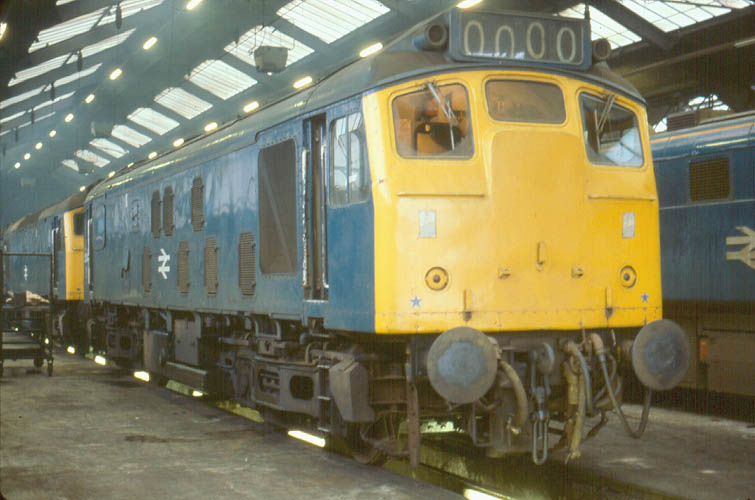
1982

1983
The following comes from the notes of Ian Hammond from a time when he was the train recorder at Watford powerbox. It reveals what could happen when the normal electric service was interrupted by a loss of power! Enjoy!
I was working as the box lad (train recorder) at Watford Power Box on the 20th December 1983 when just before my 06.00hrs to 14.00hrs shift started a southbound Freightliner pulled down the overhead wires at Bourne End just north of Hemel Hempstead. The result meant all trains had to travel via the slow lines from Watford to Tring and required diesel haulage! I spent a busy morning making lots of tea for all the bosses who were about, numerous runs to the butty shop and loads of time with my head out of the box window wishing I was on 'that' train as it passed with a Class 25 on the front!
I remember the box supervisor convinced me to go home just after 15.00hrs but after a bike ride home in the freezing cold and a quick sandwich I was back again to grab the evening peak, all diesel hauled of course and remember I was brought up in Hertfordshire on electric units and not much else! I called into the Power Box and the late turn box supervisor promptly ridiculed me in front of our regional inspector saying 'this boy has not got a home to go to - I only sent him home 2 hours ago and he's back again!'
So off I went to ride some trains, however the late turn box lad asked if I could come back so I could help out later and allow him to get home, so I only managed a few trips, how I wished I'd have stopped out a bit longer. So I returned to the Power Box, still as hectic as ever as all the night freights were being let out of Willesden and the diesels were now coming off most of the southbound passengers trains at Watford as motive power was getting a bit short on the ground.
Here is a log of my day - the first section details passing times of trains at Watford Jct.
(At this time Cricklewood was just about to loose its Class 25 fleet, the transition to the Class 31's was slower than anticipated so at the time of this article the makeup of the Class 25/31 locomotives in the London area was about 50/50 - although in this article clearly anything that strayed into the area was going to be used.
09.12hrs 25251 + 25287 ON 1A06 bound for Euston (Passenger)
09.50hrs 25226 + 310 EMU on 2D60 Special Bletchley to Euston (Passenger)
09.57hrs 25185 on 1A83 bound for Euston(Passenger)
10.47hrs 25193 on 4O83 (Freightliner) bound for Willesden
10.57hrs 25287 + 25251 on 0Z50 en route from Willesden to rescue 4E73 (Freightliner)
11.44hrs 25193 0Z40 light loco from Willesden to Bletchley
12.15hrs 47298 on 1S69 Euston - Glasgow (Passenger)
13.26hrs 25185 on 1L10 (Bullion train) bound from Willesden to Lawley St
13.28hrs 25213 + 310091+ 310093 on 2D20 Bletchley - Euston (Passenger)
1332hrs 25226 + 85026 on 6D22 Northbound freight
13.37hrs 47321 + 86315 86321 on 6D21 Southbound freight
14.11hrs 47200 + 47011 3A64 (Parcels ex Northampton) bound for Euston
14.14hrs 25226 on 6P85 southbound freight
14.50hrs 47314 + 87014 on 1M05 Glasgow - Euston (Passenger)
15.10hrs 31257 + 86XXX on 1S80 Euston - Glasgow (Passenger)
Off Duty - home for some refreshment
17.20hrs 25251 + 25287 on 1M20 Glasgow - Euston (25's detached at Watford Jct) (Passenger)
17.48hrs 25192 + 310XXX on 1L07 Euston - Milton Keynes (Ian H - hauled to Hemel Hempstead) (Passenger)
On arrival at Hemel Hempstead on the Down Fast Line was 25032 with the Willesden wiring train (attending to the OLE damage)
I departed Hemel Hempstead on 2L49 Euston to Bletchley service made up of 310052 hauled by 25258 and passed 25315 on the Bletchley wiring train at Bourne End.
I jumped off at Tring (not sure why ?) and then rode the following :
19.05hrs 47321 hauled Tring to Leighton Buzzard on 1L08 Euston to Northampton special
19.20hrs 47200 + 47011 hauled Leighton Buzzard to Bletchley on 1S83 Euston - Glasgow
Sat in the holding sidings at Bletchley ticking over were 25226 and 25224
19.36hrs 47011 hauled Bletchley to Watford Jct on 1M34 Glasgow - Euston
Back at Watford I returned to the Power Box to help my colleague out and observed the following :
20.30hrs 25199 + 86230 on 3M07 southbound parcels to Euston
20.44hrs 31116 on 7F72 northbound freight
20.53hrs 25226 + 87013 on 1M35 Glasgow - Euston (now I was cross as I'd seen 25226 sitting at Bletchley and had come back to Watford with 47011 ! ) (Passenger)
21.03hrs 25192 0Z12 light loco from Bletchley to Watford
21.17hrs 25311 + 25327 on 4Z89 Northbound freightliner
21.20hrs 47007 on 4M70 northbound Freightliner
21.20hrs 31257 + 86XXX on 1S09 TPO postal Euston to Glasgow
21.25hrs 25287 + 87006 on 5Z72 southbound ECS for Euston
21.37hrs 25192 + 87014 on 1P49 Euston - Blackpool (Passenger)
21.50hrs 25200 on 1S07 Euston - Fort William Sleeper (Passenger)
That was about it a nice 17 hour day and as I biked home I noted 25213 and 25057 arriving in Watford Yard ! - A day I will never forget.
The following is another report of the happenings that occurred on December 20th & 21st 1983 following the dewirement referred to above.
This text is pretty much as delivered to me from Nick Ross, I've not cross checked the two reports for the comparative details of the workings, so if there are any discrepancies don't worry about them, just enjoy the variety of traction that BR had available when such an event happened! And thanks to Nick and Ian for recording the workings!
Christmas comes early, December 20th/21st 1983
To a few of us local bashers Christmas came a few days early with a 36 hour "drag" courtesy of a serious wires down incident in the Bourne End area.
Tuesday December 20th
Before joining the bus to work there was just time to survey the chaos at Leighton station. The 0700 Euston commuters had been waiting a good 40 minutes for a train and were growing restless like penguins do. Eventually an already wedged 8 car Marylebone DMU set arrived and on they plied. One girly penguin was unable to get on so Railman Trevor put her in the second man's seat of the middle DMU and told her "not to touch anything". A container cover on an overnight diesel hauled liners (4E73) had come loose and brought down a long section (several miles) of the DS wires from Hemel to Tring. The Bourne End (nr Hemel) had also been blitzed which meant there was no OLE on any tracks between Hemel and Tring for the morning peak.
I begrudgingly left the chaos and went to work but a quick afternoon holiday booking saw me back around 1400 to join 310068 on a Rugby-Tring additional for a bus forward. We crossed nothing on a strangely empty main line. At Tring we arrived in the rare up bay/loop platform. A few normals joined the waiting bus but I joined the Marylebone set (51658/59750/59731/51663/51666/59753/59654/51609) seen that morning in the opposite platform. In true basher tradition I sat in the front DMU coach and so was totally out of position as 47314 dragging 87014 arrived on an up drag and stopped at a red peg on the UF. The secondman got out and phone in hand gestured for the "seven" to drop it's pan and was away before I could leap over the bridge for it. Our DMU followed the "big duff" crossing over to the UF and tottered along passing several miles of overhead lying between the DS tracks! "Sparkies" were working away but this looked a long job. Wiring train power viewed was 31191 on the Willesden train, 25315 on the Bletchley train and 25032 on the Rugby train. At King's Langley we crossed a stopping Down DMU and this needed a second glance and photo as it was a 4 car rake made up of two withdrawn St Pancras-Bedford DMU's. These must have been dug out in a panic I thought and were unheard of in the Hemel area.
A more regular (at weekends) Tyseley set followed then with a loud warning blast on the horn 31257 dragging another 87 passed us on the Watford curve. That was all that was on the move all the way to Euston. The terminus itself was equally eerie with just a few DMU's/310's and two rakes of Cobbler stock in. Two 47's were parked up on the stabling road where the "roarers" normally parked. Passengers and penguins milled around in the usual confusion that only serious farces bring. My DMU quickly left but then gen was obtained that some commuter trains would run plus a few Euston-Glasgow's. A 1600 Euston-Bletchley was then advised as departing from platform 12. I was pleased at seeing it was a hauled rake with a class 83 having brought in the 10 Mk I's in. The rake very quickly filled and with front coach seats bagged 25213 backed on! A very loud (no banker) attack on Camden Bank followed, some normals in the leading coach requested that the toplight windows be closed as they were unused to Sulzer music! Approaching the first stop, Watford I wondered whether to stay on board as the juice maybe restored but eventually opted to bail in nerd like fashion!
Twenty minutes later the 1615 Euston-Northampton arrived with 25175 dragging 310’s 078/093. The packed 310’s had just emergency lighting to add to the atmosphere as it was now dark. The 310’s guard acknowledged the platform tip, rung his bell, the 310 driver blew his horn, the rat acknowledged and thrashed off into Watford tunnel.! Truly outrageous especially so on your doorstep!
A Hemel bail saw 25251/25287 on an up Glasgow drag ease up to drop off a driver but no way could I leap on. So the Marylebone DMU was joined again returning me South. We crossed 25192 (not confirmed) on another Euston-Northampton Mk 1 turn whilst 47314 was just arriving at Watford on a Euston-Glasgow drag. I flagged off the “duff” and 47321 on the next Euston-Northampton Mk I turn. To me 25’s were much rarer than 47’s but I was beginning to question my decision when 47011 then appeared on another Northbound drag.
For once patience paid off, 25287 (dud) had been split from the pairing at Euston and was dragging two 310’s to Northampton. I flagged this too and as hoped for 25251 returned on a Euston-Rugby Mk I rake twenty long minutes later. I bailed at Hemel to await the next drag but the station staff here told me the bad news that “there were no more trains” and I was put on a bus to Tring.
As I got on 310058 sitting in Tring loop 25226 briefly stopped dragging 87033 on another Glasgow-Euston but this too was flagged as it was getting late. On the US just North of Tring a light 40058 was checked waiting for us to clear….did this drag as well????
The Moves*
068 Rugby-Tring Addit
L.Buzzard-Tring 51658, 59750, 59731, 51663 + 51666, 59753, 59654, 51609 1435 Tring-Euston Addit
Tring-Euston
25213 1600 Euston-Bletchley Addit (load 10) Euston-Watford Jn
25175} 1615 Euston-Northampton Watford Jn-H. Hempstead
078 (d)
093 (d}
2 x 4 Car DMU xxxx Tring-Euston H. Hempstead – Watford Jn
25251 1810 Euston-Rugby Addit Watford Jn – H. Hempstead
Bus xxxx Hemel-Tring Addit H.Hempstead - Tring
058 2035 Tring-Birmingham Tring-L. Buzzard
Other Gen*
25251 & 25287 0740 Northampton-Euston
25226 0825 Bletchley-Euston Addit
3100xx
25185 0810 Northampton-Euston
47298 1150 Euston-Glasgow 1S69
25213 1240 Bletchley-Euston
310091
310093
31257 & 87xxx 1445 Euston-Glasgow
47314 & 87xxx 1645 Euston-Glasgow
25192 1652 Euston-Northampton
25258 1658 Euston-Bletchley
310052
47011 & 86254 Euston-Glasgow Addit
47200 1750 Euston-Glasgow Addit
47321 1700 Euston-Northampton Addit
25287 1750 Euston-Northampton (2x 310)
47011 0720 Glasgow-Euston
47314 & 87014 (d) 0910 Glasgow-Euston
25251 & 25287 1115 Glasgow-Euston
25226 & 87033 xxxx Glasgow-Euston
25192 & 87014 1905 Euston-Blackpool
25200 2100 Euston-Fort William/Stranraer Sleeper
Wednesday December 21st 1983
My flat in Leighton at the time overlooked the WCML and sleep was difficult as it was non stop class 25 thrash as Bletchley men and loco’s kept the West Coast moving. The drags continued throughout the night with rats on virtually everything. BY train crews were raking in the overtime, “Bletchley’s finest hour”.
I got down the station just after 6am and was pleased to be advised the juice was still off in the problem section. The silence was shattered by 25193 and the rare 25109 storming South on a sleeper/night rider service. A 310 arrived from Tring and was taken to M. Keynes. This was my first dud move of the day, as unbeknown to me, the hauled G06 Euston-Birmingham turn was running and called at Leighton. The drag power to Bletchley was 47314, this loco having done more passenger turns in the last 24 hours than in the whole of 83… .Anyway I viewed it heading North l/e at the Keynes apparently returning to it’s booked oil train duties from Bedworth to Immingham.
The penguins hovered and we were all rewarded with 25236/25199 dragging 87008 on a Wolves-Euston calling all big shacks. A pathetic 3.19 miles were taken for a Bletchley bail. About 10 minutes later 47340 arrived on a Northampton-Euston Mk 1 turn which I did back to Leighton. Then unfortunately it was off to work. The power remained off till mid morning and even 56041 off the Stoke Gifford-Wolverton stone train was hijacked on Bletchley flyover and “borrowed” for a few drags…Power was restored around 1100 , it then failed again, but all was back to normal by 1300.
The Moves*
094 xxxx Tring-Birmingham Addit L.Buzzard-M.Keynes
25236 & 25199 + 87008 M.Keynes-Bletchley 0700 Wolverhampton-Euston
47340 0740 Northampton-Euston Bletchley-L.Buzzard
Other Gen*
25193 & 25109 2250 Glasgow/Inverness-Euston
47314 0620 Euston-Liverpool (to Bletchley)
* specific train times are not confirmed as an emergency timetable was in operation and kept changing all the time but I wasn’t complaining!
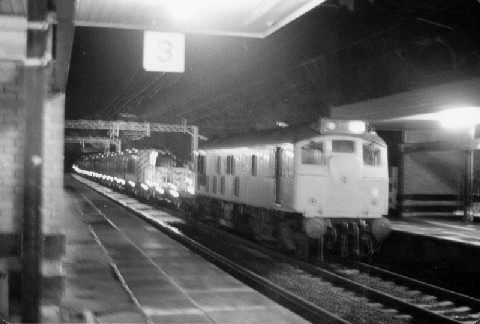
1984
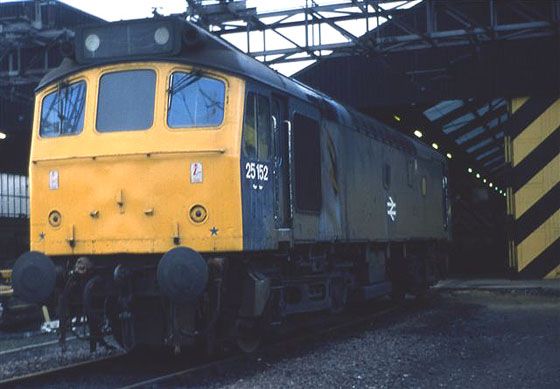
1985

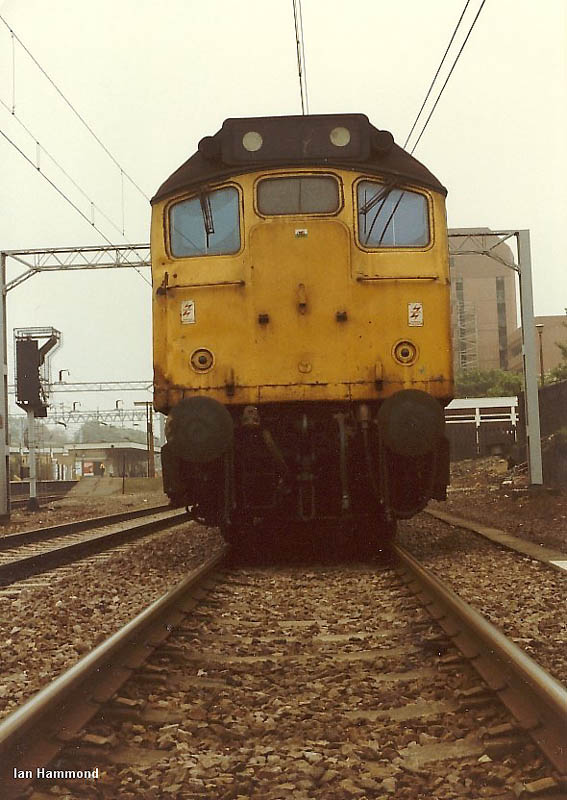

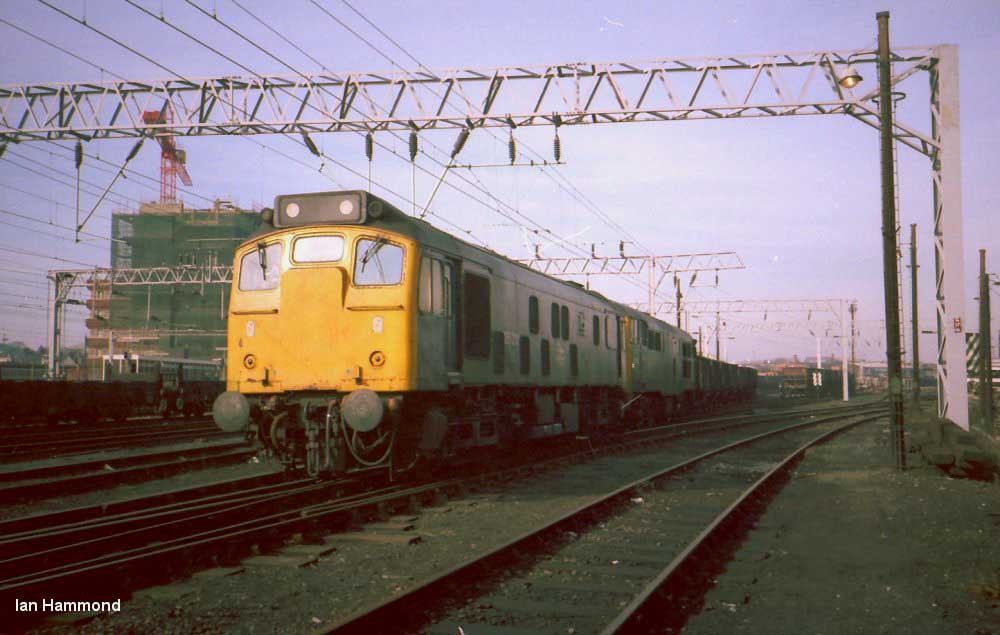

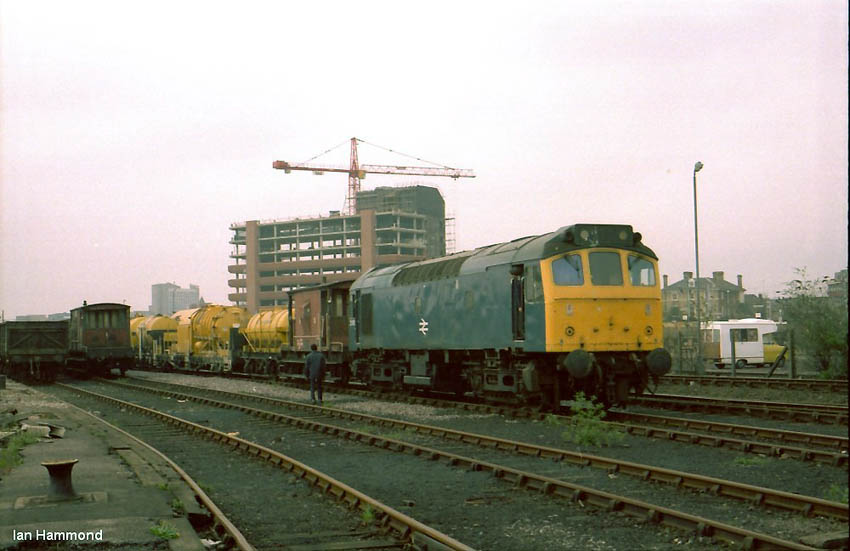
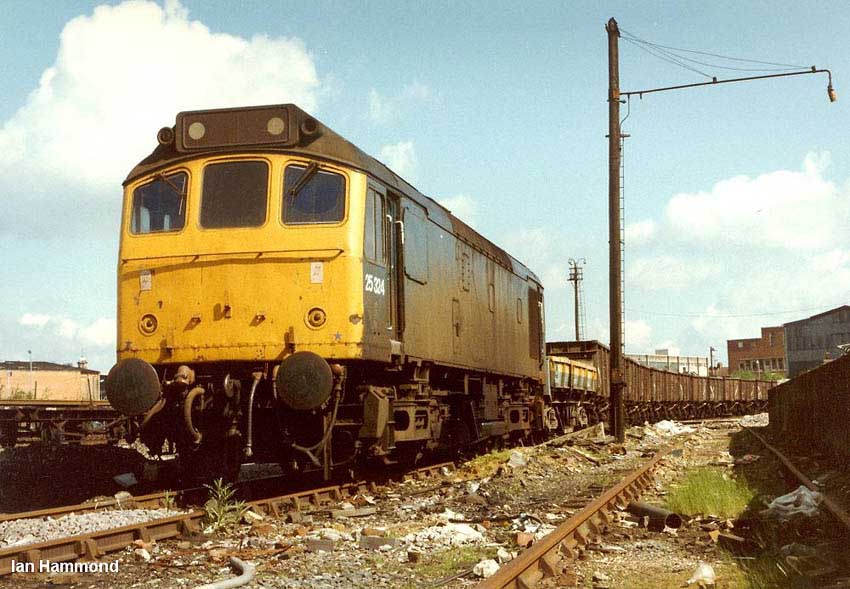
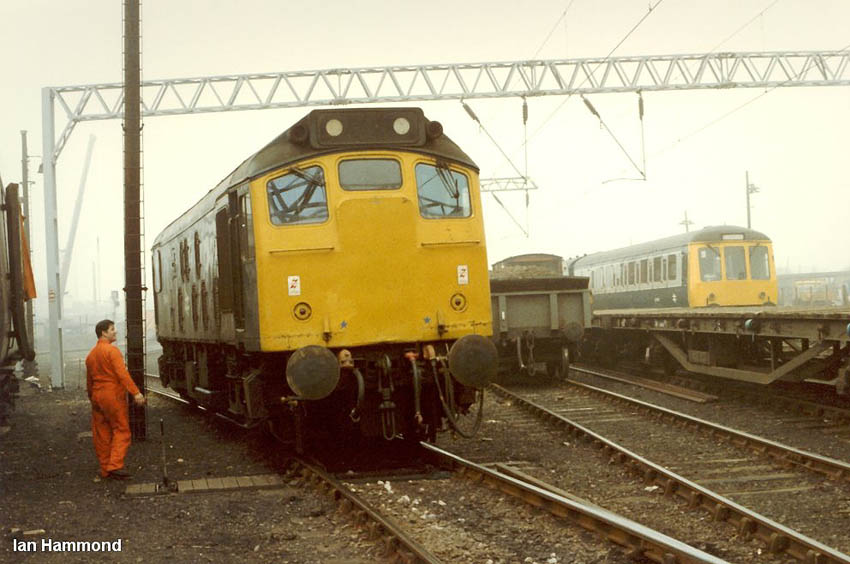
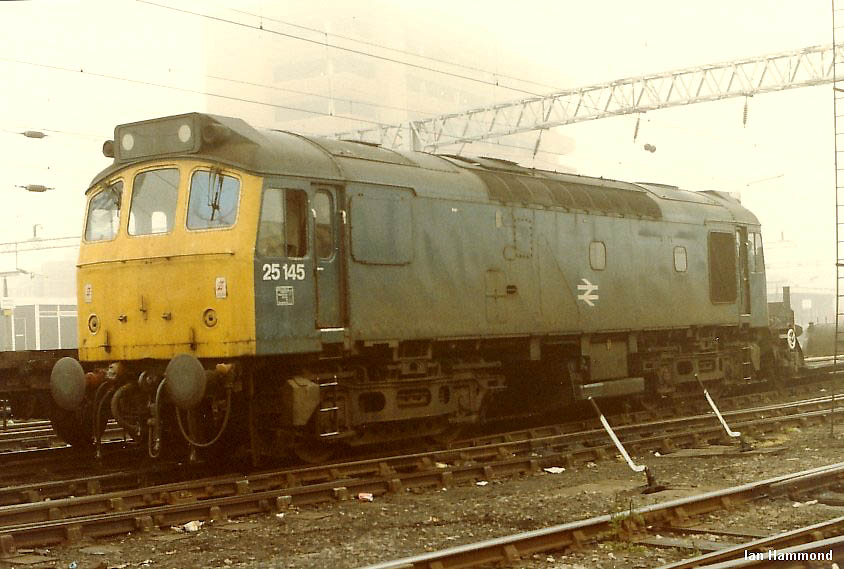

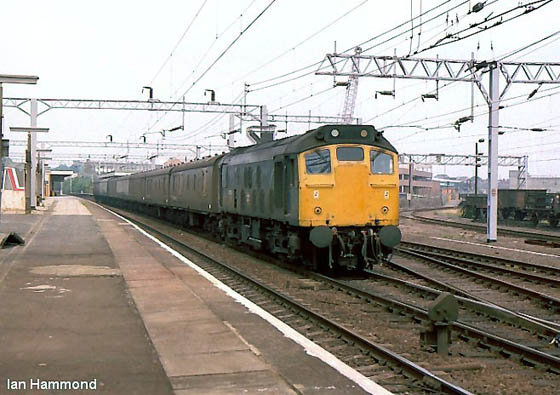
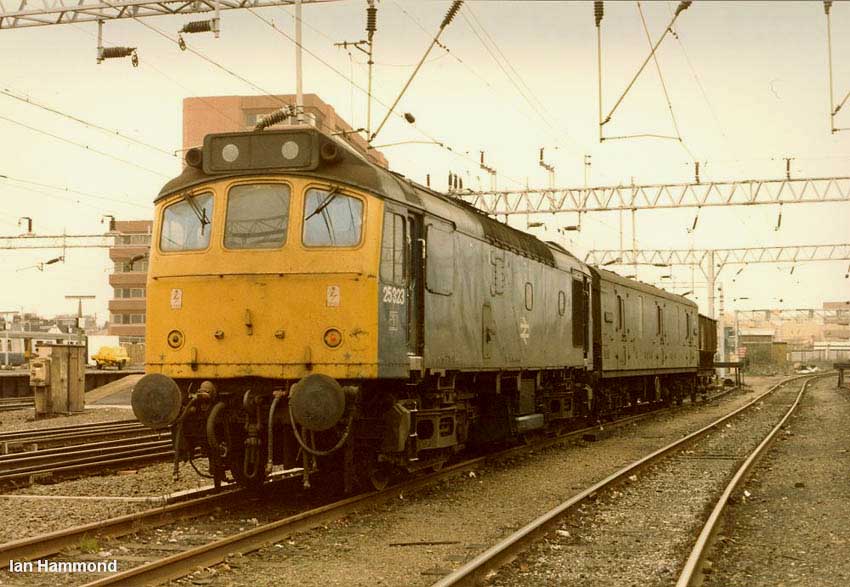
1986


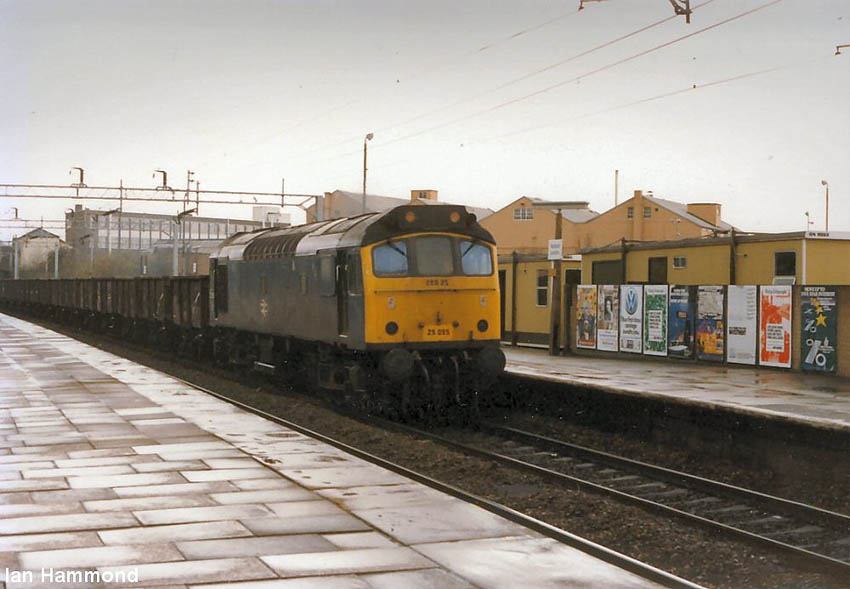
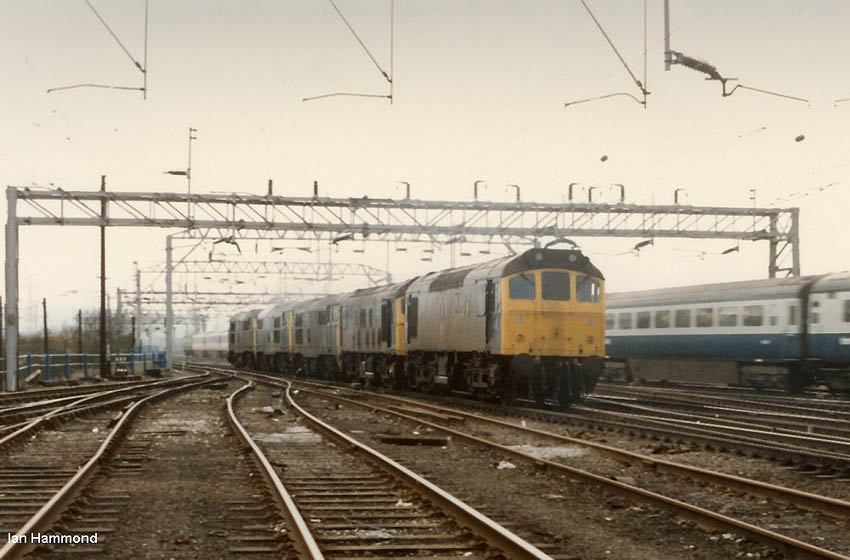


Page added July 8th 2001.
Page updated June 13th 2020.